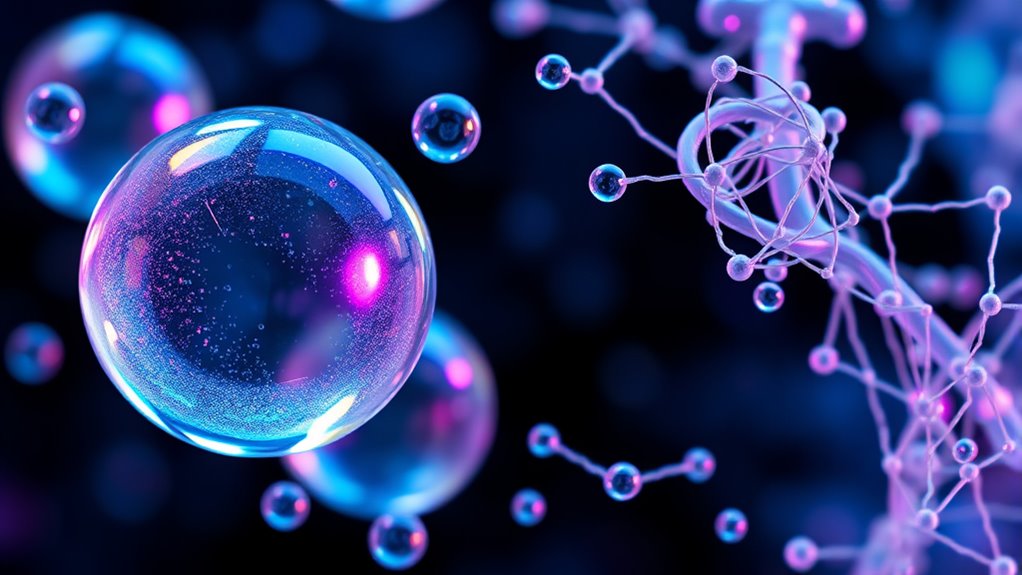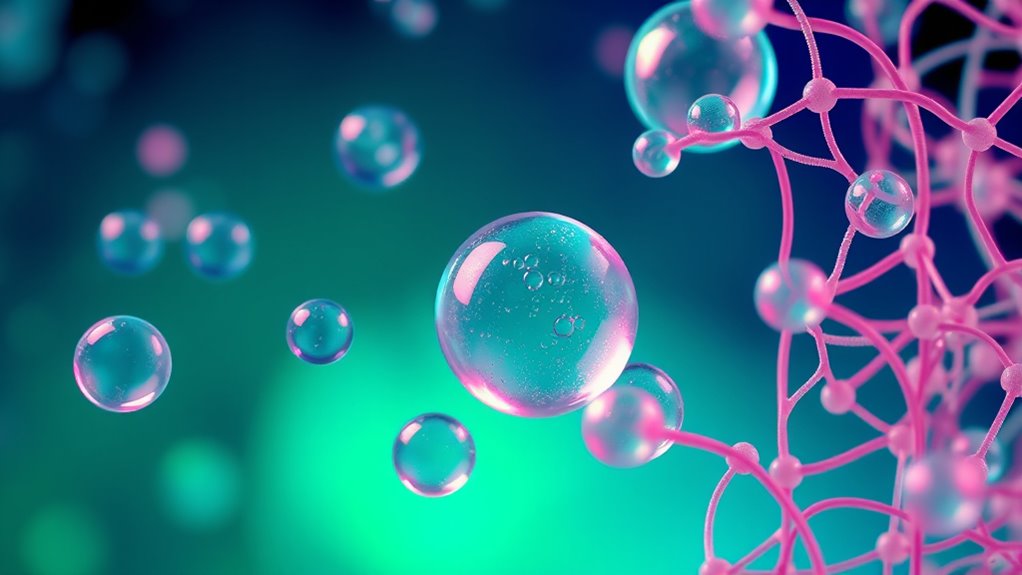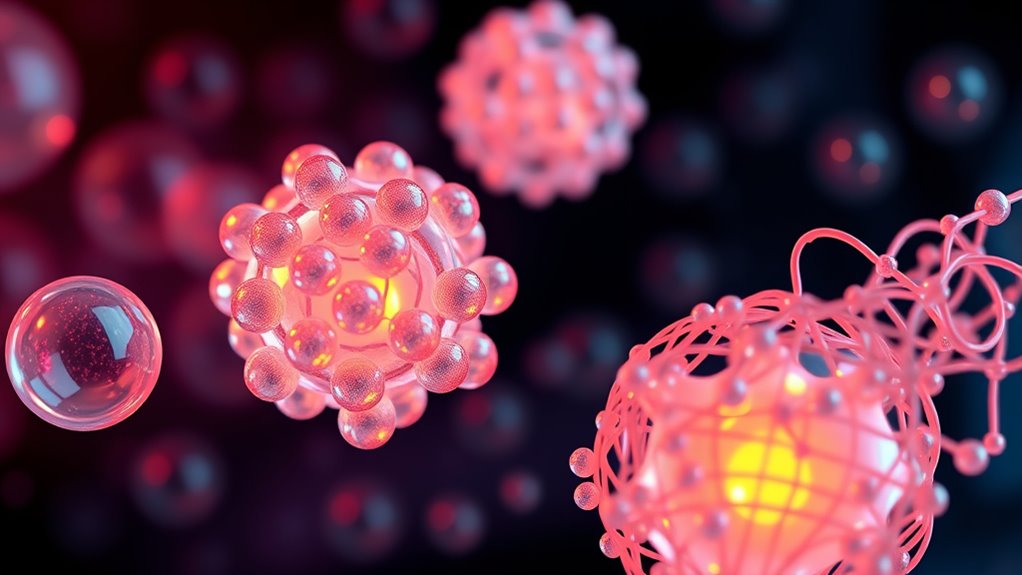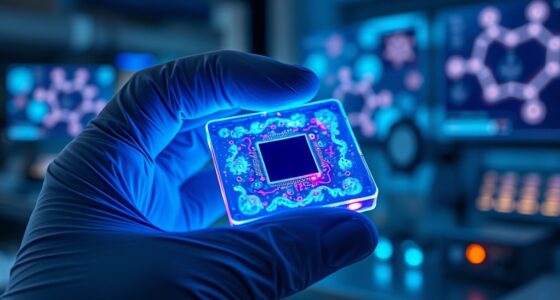Nanocarrier systems like liposomes, micelles, and polymers help you improve drug delivery by protecting drugs, targeting specific tissues, and controlling release rates. Liposomes carry both hydrophilic and hydrophobic drugs, while micelles are great for solubilizing poorly soluble compounds. Polymers offer customizable stability and release profiles. Each system has advantages and some challenges, like stability or manufacturing issues. Exploring further reveals how these nanocarriers could transform your therapeutic approaches.
Key Takeaways
- Liposomes, micelles, and polymers are versatile nanocarriers with unique architectures for drug encapsulation and delivery.
- Liposomes have a lipid bilayer core that can carry both hydrophilic and hydrophobic drugs, offering biocompatibility.
- Micelles are small, surfactant-based structures ideal for solubilizing poorly soluble hydrophobic drugs.
- Polymers provide customizable, stable platforms for controlled and sustained drug release, with potential toxicity concerns.
- Each system offers specific advantages and challenges, influencing their suitability for targeted therapy applications.
Structural Characteristics and Composition

Nanocarrier systems typically consist of a core structure surrounded by a protective shell, designed to carry therapeutic agents efficiently. The core often comprises lipids, polymers, or other biocompatible materials that encapsulate or embed the drug molecules. This core provides stability and protects the payload from degradation. Surrounding this core, you’ll find a shell made of lipids, surfactants, or polymers, which helps prevent premature release and enhances targeting capabilities. The composition of these layers can be tailored to optimize drug loading, release rates, and compatibility with biological environments. Variations in structure—such as spherical liposomes, micelles, or polymeric nanoparticles—depend on the materials used and the intended application. Overall, the specific architecture determines how effectively the nanocarrier can deliver its therapeutic cargo. Regular monitoring of nanocarrier stability is essential to ensure optimal performance and safety during drug delivery.
Applications in Drug Delivery and Therapy

Nanocarrier systems have revolutionized drug delivery by enabling targeted and controlled therapeutic interventions. They allow you to deliver drugs directly to specific tissues or cells, reducing side effects and increasing efficacy. Liposomes, micelles, and polymers can encapsulate a variety of drugs, including poorly soluble compounds and biologics, protecting them from degradation. These systems improve drug stability, control release rates, and enhance bioavailability. You can modify surface properties to evade immune detection or target particular cell types, making treatments more precise. In cancer therapy, for example, nanocarriers deliver chemotherapeutics directly to tumor cells, sparing healthy tissue. Their versatility extends to gene delivery, vaccines, and anti-inflammatory treatments, demonstrating their broad potential in modern medicine.
Advantages and Challenges of Each System

While nanocarrier systems offer significant advantages in targeted drug delivery, each type presents its own set of benefits and challenges. Liposomes excel at encapsulating both hydrophilic and hydrophobic drugs and are biocompatible, but they can be unstable and costly to produce. Micelles are easy to prepare, offer good solubilization of hydrophobic drugs, and have small sizes for better tissue penetration; however, they often have limited drug loading capacity and stability issues in the bloodstream. Polymers provide customizable properties, controlled release, and structural stability, yet they may raise concerns about toxicity and complex manufacturing processes. Additionally, the biocompatibility of each system plays a crucial role in their successful application. Understanding these advantages and challenges helps you select the most suitable nanocarrier system for specific therapeutic needs.
Frequently Asked Questions
How Do Nanocarrier Systems Influence Targeted Drug Release Timing?
Nanocarrier systems control targeted drug release timing by responding to specific environmental triggers like pH, temperature, or enzymes. When these conditions are met, the nanocarriers break down or change structure, releasing the drug precisely where needed. You benefit from this targeted approach because it minimizes side effects and guarantees the drug acts at the right site and time, improving overall treatment efficiency and patient outcomes.
What Are the Environmental Impacts of Nanocarrier Disposal?
You should consider that nanocarrier disposal can impact the environment through potential toxicity and accumulation. When not properly managed, these tiny particles may contaminate water and soil, harming aquatic life and ecosystems. They could also enter food chains, posing health risks. To minimize these effects, it’s vital to develop safe disposal methods, promote biodegradability, and follow regulations that reduce environmental contamination from nanomaterials.
How Do Nanocarriers Interact With the Immune System?
You find that nanocarriers can cleverly camouflage themselves, causing the immune system to either ignore or attack them. They interact through surface signals, sometimes triggering immune responses like inflammation, or evading detection to deliver drugs unnoticed. This delicate dance depends on their design, surface properties, and size. Understanding this interaction helps you optimize nanocarriers for safer, more effective therapies, avoiding unintended immune activation or suppression.
Can Nanocarriers Be Customized for Specific Disease Biomarkers?
Yes, you can customize nanocarriers to target specific disease biomarkers. You do this by attaching ligands, antibodies, or peptides to their surface, which recognize and bind to the unique markers on diseased cells. This precise targeting enhances drug delivery, minimizes side effects, and improves treatment efficacy. By tailoring these surface modifications, you guarantee that the nanocarriers selectively interact with the intended biomarkers, making your therapy more effective.
What Are the Cost Considerations for Large-Scale Nanocarrier Production?
You should consider that large-scale nanocarrier production involves high initial investments in equipment and materials, which can drive up costs. Additionally, maintaining strict quality control and ensuring batch consistency adds expenses. Manufacturing processes need to be efficient to reduce waste and time. Regulatory compliance also requires resources for safety testing and documentation. Overall, balancing cost-effectiveness with quality and regulatory standards is key to successful large-scale production.
Conclusion
You might think all nanocarrier systems are equally effective, but recent studies suggest liposomes, micelles, and polymers each excel in specific applications. While some claim polymers are universally superior, evidence shows that liposomes’ biocompatibility and micelles’ stability often outperform others in targeted delivery. So, it’s worth questioning whether a single system suits every need—perhaps combining these carriers could reveal even greater therapeutic potential, challenging the idea that one size fits all in nanocarrier technology.









